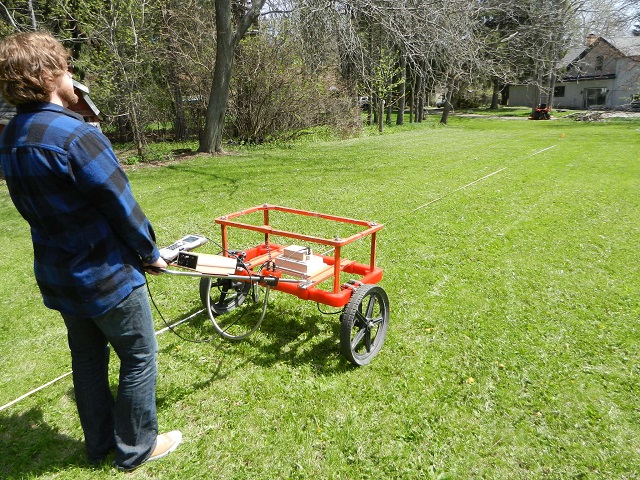
EM61 detection of ferrous and nonferrous metals
Will the EM61 detect both ferrous and nonferrous metals? Yes! The EM61 does, in fact, respond to both ferrous and non-ferrous metals! Let’s first quickly review how the EM61 detection occurs. The EM61’s transmitter coil carries a current that creates a strong primary magnetic field that has the potential to intercept a metal target. Once the transmitter current is stopped, the primary magnetic creates a voltage within the target that causes current to flow. This current creates a secondary magnetic field, which is sensed by the receiver coils. Because the primary magnetic field is stronger than the secondary magnetic field, response is measured after the transmitter current is ceased.
Once the transmitter no longer produces a current / primary magnetic field, the metal target’s current is a monotonically decaying waveform. The maximum amplitude of the waveform and the duration of the transient current are determined by the target’s size, position relative to the EM61 coils, and electrical properties. As the current disappears so does the secondary magnetic field.
Target properties with a high electrical conductivity and high magnetic permeability will result in a stronger and longer lasting magnetic field. Better electrical conductivity results in more current being established from the primary magnetic field. A larger current produces a larger secondary magnetic field. Obviously, a high magnetic permability, the ability of a target material to support the formation of a magnetic field within itself, means that target is able to possess a magnetic field for a larger duration of time. Therefore, metals with high conductivity and high magnetic permability have a stronger and longer-lasting secondary magnetic field measured by the EM61. For this reason, some metals, specifically ferrous metals, have a larger amplitude response when the EM61 performs geophysical investigations. Other metals have a significantly smaller response because either the magnetic field is neither large enough nor long lasting enough for the EM61 to record.
With that being said, target with more mass, regardless of metal type, will always have a stronger response than the same metal type with a lower mass. Additionally, targets of the same type and size may have different responses depending on the orientation of the material. Larger surface areas in relation to the EM61’s coils will provide larger responses.
If you ever looked at the EM61, you may have noticed the handle and pins are metal! How does this not affect the accuracy of the EM61? Didn’t you just explain the that both ferrous and nonferrous metals are susceptible to EM61 detection? Well, I tried to. Think about why the handles may not affect the EM61 readings!
The type of stainless steel used throughout the EM61 construction possesses little magnetic permeability, meaning that the magnetic field dissipates before there a response is recorded. Remember the EM61 transmitter coils wait until the transmitter coil is not producing current to record a response. Furthermore, the size and relative surface area in relation to the EM61’s coils is not large enough to warrant a response given its already subpar qualities for being detected by the instrument.
Geonics Training .com would like to acknowledge and thank Mike Catalano and Geonics for providing the necessary information to answer .
